LEATHERTOWN JAZZMEN, Delia Gone, 1961
Posted: February 28, 2013 Filed under: 60s, Jazz Records 2 Comments


 Compared to the Dixieland songs from flexi discs that I´ve posted lately, the Leathertown Jazzmen were the real thing. Maybe not in the sense that their playing was more authentic, but at least the Leathertown Jazzmen were full-time Jazzmen.
Compared to the Dixieland songs from flexi discs that I´ve posted lately, the Leathertown Jazzmen were the real thing. Maybe not in the sense that their playing was more authentic, but at least the Leathertown Jazzmen were full-time Jazzmen.
Most groups who played early jazz in the 50s were decidedly amateur. They believed that if they wanted to stay true to the original New Orleans players, who were predominantly amateurs, they must also stay amateurs. Nevertheless, the youthful and talented Leathertown Jazzmen (Otto Zitzelsberger, John Howlett, Armin Johl, David Meggeson, Horst Brandt and Roy Pellet), a mixed group of British and German musicians, were in such high demand, that they were able to turn pro in 1960. They toured Germany, England, Spain and Norway. In August 1962 they appeared at the International Jazz Festival in Comblain-la-Tour, near Liege in Belgium, in front of 35.00 people. Apart from the instruments they´re holding in the picture (clarinet, trombone and banjo), they look like a rock´n´roll group. The Leathertown Jazzmen were from Offenbach, a town that until the 1950s was known for its large leather industry. Since then, that has changed dramatically. Due to many companies moving their businesses to countries with lower wages, from the 1.339 leather companies that were counted in Offenbach in 1907, only 19 remained in the year 2000.
As far as I know, the Jazzmen recorded at least one more 45 for the Pye label in 1962 (Heidelberg/Rosamunde, Pye 7N 3113) , but none of them have been reissued in fifty years. Delia Gone, written and recorded by Blind Blake in 1949, tells the true story of the murder of Delia Green on Chrismas Eve 1900. Interesting trivia according to Wikipedia: “Delia Gone” was prominently covered by The Kingston Trio, Pete Seeger and four times by Johnny Cash. In the music video for Cash’s fourth recording, Delia is played by Kate Moss.
The Leathertown Jazzmen´s version of Delia Gone is pretty close to the version of Acker Bilk. I still like The Jazzmen´s version better. It´s a little more rootsy…
LEATHERTOWN JAZZMEN, Delia Gone, 1961
LEATHERTOWN JAZZMEN, Thriller Rag, 1961
Die Heinomaschine
Posted: February 26, 2013 Filed under: Comics 2 Comments Illustration has appeared in Jungle World and Ox Fanzine.
Illustration has appeared in Jungle World and Ox Fanzine.
DIE SKYPIPERS, Red River Rock, 1959
Posted: February 23, 2013 Filed under: 50s, Flexible Records, Germany, Instrumental Records, Rock´n´Roll Records 6 Comments WTF!? That´s what I thought today, when I heard this song for the first time. But somehow it also made perfect sense. So much sense that I wondered if I had ever really listened to the original version of Red River Rock. I mean really really LISTENED closely. Because on this version, the famous melody is played on a Blockflöte – a recorder. And it just sounds right. Was that a recorder, that I had never noticed, in the original version, too? This little school kid instrument? I actually immediately went to check…
WTF!? That´s what I thought today, when I heard this song for the first time. But somehow it also made perfect sense. So much sense that I wondered if I had ever really listened to the original version of Red River Rock. I mean really really LISTENED closely. Because on this version, the famous melody is played on a Blockflöte – a recorder. And it just sounds right. Was that a recorder, that I had never noticed, in the original version, too? This little school kid instrument? I actually immediately went to check…
Of course in the Johnny and the Hurricanes version its a Hammond organ! Played by Paul Tesluk on a Hammond Chord Organ. Pfff, I was worried there for a short time…
On this German flexible budget 45 the recorder, according to the label played by a certain Fred Brass, aptly mimics a Hammond organ. Sweet!
DIE SKYPIPERS, Red River Rock, 1959
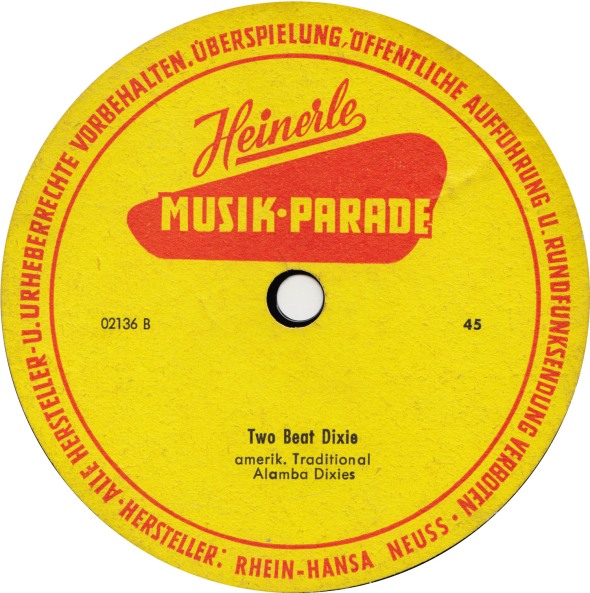 The other side is Dixieland. German budget Dixieland and I´m pretty confident, that the people who recorded this song and the people who bought the record didn´t have any idea what they were playing and listening to. In the 50s Germany was just too far away from Dixie. Nevertheless this version is not even so bad. It´s a pretty carefree trad-style jazz song, including nice trumpet, clarinet, banjo, saxophone, even a short drum solo! There is a lot of music out there that is way worse…
The other side is Dixieland. German budget Dixieland and I´m pretty confident, that the people who recorded this song and the people who bought the record didn´t have any idea what they were playing and listening to. In the 50s Germany was just too far away from Dixie. Nevertheless this version is not even so bad. It´s a pretty carefree trad-style jazz song, including nice trumpet, clarinet, banjo, saxophone, even a short drum solo! There is a lot of music out there that is way worse…
ALAMBA DIXIES, Two Beat Dixie, 1959
This is the packaging of Heinerle-Flexis at newsstands. Music for kids:
MOUSTACHE, Stompin´at the Savoy
Posted: February 21, 2013 Filed under: 50s, France, Jazz Records 3 Comments
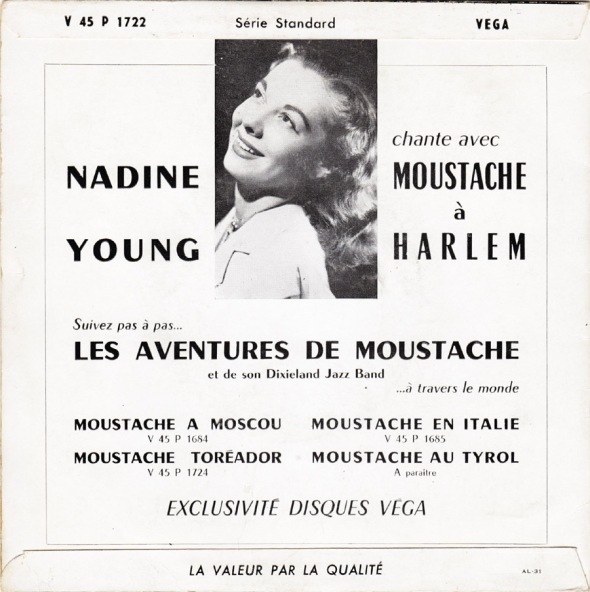

 Drummer, band leader and actor François-Alexandre Galepides, alias Moustache (1929-1987), was a big name in French post-war jazz with quite a few releases in the 1950s. He started to play in Claude Luter´s band and later performed with Sidney Bechet and George Brassens. Moustache even recorded some funny early rock´n´roll sides like Le Croque-Crâne-Creux (Purpe People Eater) with French lyrics written by Boris Vian. From what I understand he also really enjoyed playing rock´n´roll, contrary to guys like Henri Salvador, Boris Vian and Michel Legrand. Henri Salvador recorded some excellent early French rock´n´roll, but still only regarded it as satire, a part of his job as a comedian. Decades later he hated it when rock´n´roll fans pestered him about his Rock´n´Roll Mops. Personally he preferred the swinging jazz music he grew up with. Moustache apparently was a much more down-to-earth kinda guy. In the mid-50s he also ventured into acting and comedy, mostly playing musicians in films. Later he owned a restaurant and ran several bars. Moustache died in a car accident in 1987.
Drummer, band leader and actor François-Alexandre Galepides, alias Moustache (1929-1987), was a big name in French post-war jazz with quite a few releases in the 1950s. He started to play in Claude Luter´s band and later performed with Sidney Bechet and George Brassens. Moustache even recorded some funny early rock´n´roll sides like Le Croque-Crâne-Creux (Purpe People Eater) with French lyrics written by Boris Vian. From what I understand he also really enjoyed playing rock´n´roll, contrary to guys like Henri Salvador, Boris Vian and Michel Legrand. Henri Salvador recorded some excellent early French rock´n´roll, but still only regarded it as satire, a part of his job as a comedian. Decades later he hated it when rock´n´roll fans pestered him about his Rock´n´Roll Mops. Personally he preferred the swinging jazz music he grew up with. Moustache apparently was a much more down-to-earth kinda guy. In the mid-50s he also ventured into acting and comedy, mostly playing musicians in films. Later he owned a restaurant and ran several bars. Moustache died in a car accident in 1987.
The back of the sleeve lists three other EPs in what appears to be a series of musical trips: Moustache a Moscou, Moustache Toréador, Moustache en Italie and Moustacha a Tyrol. As illustrated by the nice cover design done by Max Dufour, house illustrator for the French Festival label, on this record the Stache takes a trip to Harlem. The three jazz standards are quite faithfully trying to recreate a swingin´ 1930s mood. In his fast instrumental version of Chick Webb´s Stompin´at the Savoy the Savoy Ballroom is coming to life, while Duke Ellington´s Just Squeeze Me (But Please Don’t Tease Me) and the traditional Frankie and Johnny, both sung by Nadine Young, are played in a nice easy going mid-tempo…
MOUSTACHE ET SON DIXIELAND JAZZ BAND, Stompin´at the Savoy
NADINE YOUNG AVEC MOUSTACHE ET SON DIXIELAND JAZZ BAND, Frankie and Johnny
NADINE YOUNG AVEC MOUSTACHE ET SON DIXIELAND JAZZ BAND, Just Squeeze Me
HETTLAGE ALL-STARS, Manhattan Spiritual
Posted: February 19, 2013 Filed under: 60s, Flexible Records, Jazz Records, Promotional Records 6 CommentsThree years ago I wouln´t have looked twice at a Dixieland record. But then I found some Dixieland/Trad Jazz 45s from the early 50s to early 60s and started to like them. So far I haven´t met anyone who shares this interest and so far nobody snatches those 50 cents records up before I do. But it also means no communication. Punk, garage, indie or 70s rock record collectors still talk music in record shops all the time, but not Jazz fans. There might be some Dixieland fans out there, but they don´t hang out in record stores and probably just buy CDs on Amazon. But that´s all fine with me. When I buy 45s by Edmond Hall, Bunk Johnson, George Lewis or Sidney Bechet, I do it unsupervised and without any competition by other collectors. Right now Dixieland means worthless. Nobody seems to care for this stuff and that goes double for 1950s Traditional Jazz groups from Europe and triple for anything that only loosely had the Dixieland tag attached to.
Like this record by Hettlage-All-Stars. Hettlage, founded in 1896, was a German clothing retail company that went bankrupt in 2004. In the 50s, when they were still doing good business and operated a number of clothing stores, they chose teenager´s favorite product, the 7″ record, to advertize their new Twenty clothing line for teenagers. They could have put some Rock´n´Roll or simply Schlager songs on the record but they decided to put two Jazz hits on a very thin piece of plastic and to make the package look a little cooler, opted for a thick cardboard sleeve and a design that incorporated an abstract painted for a background, some stylized musical instruments and a silhouette of a trumpet player on the label, that is reminiscent of the logo that David Stone Martin designed for Noman Granz Clef label.
Manhattan Spiritual was a hit for Reg Owen and his orchestra in 1959, which peaked at #10 in the Billboard Hot 100. Whereas Reg Owens original Big Band Swing version had a bold brass section, the Hettlage All-Stars small combo version makes quite effective use of piano and clarinet improvisations. Not bad at all for an anonymous band playing on a flexible throw-away advertisement record…
HETTLAGE ALL-STARS, Manhattan Spiritual
HETTLAGE ALL-STARS, When The Saints Go Marching In
The models (Heinz Feldhaus, who is holding the Hettlage All-Stars record sleeve, and actor Margita Scherr) are standing in front of an air-brushed record rack holding funny looking cell phones to their ears…
ERICH BÖTTCHER, Frechdachs
Posted: February 15, 2013 Filed under: 60s, Cartoon Sleeves, Promotional Records 2 CommentsThis record advertized for a brand of acrylic paint produced by the defunct Brander Farbwerke out of Bochum-Gerthe. The first song Wer Indurin probiert... is pure advertisement. However, the simple and homemade manner in which Erich Böttcher is asking the listener to test Indurin acrylic paint is strangely endearing:
ERICH BÖTTCHER, Wer Indurin probiert
Usually this song would be enough to serve the purpose. Somehow though, Böttcher managed to fill the other side of the record with almost four minutes of half-improvised Hammond organ playing on his self-written instrumental Frechdachs (rascal):
I´ve had this flexible 7″ record long before I discovered that Erich Böttcher was also featured on another record I had in my possession. The compilation Vorhang auf – umblättern – Nichts für zarte Seelen (not for the faint of heart) featured mostly risqué material by Gisela Jonas, Inge Brandenburg and Mady Rahl and was geared at adults. Again the purpose of the record seems to have condemned it. By the 1970s tastes had changed and these type of songs were considered old fashioned. Böttcher recorded at least two LPs together with Jens Brenke, a comedian and owner of the Hannover cellar bar Jenseits (in German: The Afterlife) from 1960 to 1980. Both records (Nachtlokal frei Haus, 1962 and Die Mitternachtsplatte, 1964) were live recordings from the bar. Another Böttcher LP was the saucy Sexpresso bitte! A couple of tracks of the Nachtlokal Lp also appeared on the compilation Nichts für zarte Seelen :
ERICH BÖTTCHER, Annabella will mir heute Nacht was tun
For some time Erich Böttcher lived and worked in Hannover, Northern Germany, before going to the southern small town of Bad Mergentheim, near Würzburg, where his Sexpresso bitte – Live at Café Helén LP was recorded. But apart from those few recordings I couldn´t find any information about Erich Böttcher, his career or his life. Were did he live? Did he continue to perform and record? Or did he start another profession? What happened to Erich Böttcher? None of his songs have ever been reissued. All of this happened long before the Internet, so there´s no trace of him. No clue either, who the nameless cartoonist is, who did these cute little drawings:
What the heck, here´s three more songs from the Nichts für zarte Seelen LP. The rest of the tracks are crap but these I like. Not surprisingly none of them have made it into the digital age. Until now…
JENS BRENKE & ERICH BÖTTCHER, Was eine Frau im Frühling träumt
Elfie Pertramer (1924 – 2011) was an actress from Munich, Bavaria who played in Heimatfilmen but also did some cabaret. Apparently this odd little tune was never issued as a single and only appeared on this LP. Elfie Pertramer is singing seductively in a cabaret style:
ELFIE PERTRAMER, Piccadilly 91726
Hugo Strasser, born in Munich in 1922, started playing the clarinet in Max Greger´s group in 1949. He put together his first own big band in 1955 and became a fixture in German entertainment for decades. Strasser still performs occasionally.
HUGO STRASSER UND SEIN TANZORCHESTER, Mexico-Twist
Wasserturm Swing
Posted: February 1, 2013 Filed under: Jazz Records, Real Life, Swing Records Leave a comment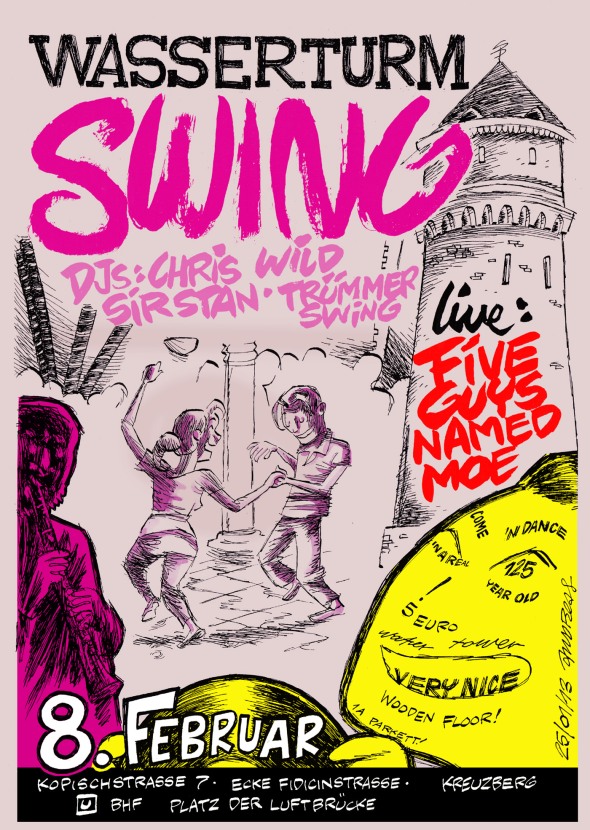 There´s a nice community space in my neighborhood that gave me the idea to have another dance party:
There´s a nice community space in my neighborhood that gave me the idea to have another dance party:
Wasserturm Swing
Friday, February 8th 2013
at Wasserturm, Kopischstrasse 7 in Kreuzberg (Kopischstrasse on the corner of Fidicinstrasse, 2 minutes from subway station Platz der Luftbrücke)
Wasserturm is a real 125-year old water tower in the center of the historic Chamisso area in Kreuzberg. It offers 70 square meters of nice wooden floor, a small stage with a piano and full back line, high ceiling with super acoustics and no noise outside because of the extra thick walls of the water tower and a small bar.
Some records I´m going to play:
1. COLEMAN HAWKINS AND HIS ORCHESTRA, What Harlem Is To Me, 1935
2. LOUIS ARMSTRONG AND THE MILLS BROTHERS, Boog-It
3. FATS WALLER WITH EDDIE CONDON´S DIXIELANDERS, Oh Sister Ain´t That Hot, 1940
4. COZY COLE´S BIG SEVEN, Sweethearts On Parade, 1950
5. JOHNNY HODGES AND HIS ORCHESTRA, Standing Room Only
6. MAHALIA JACKSON, Walking To Jerusalem
7. KID ORY´s CREOLE JAZZBAND, Weary Blues, 1945
8. SIDNEY BECHET & MEZZ MEZZROW, Revolutionary Blues, 1947
9. THE NAT KING COLE TRIO, Gone With The Draft, 1940
10. TAB SMITH, Can´t We Take A Chance, 1951
11.COLEMAN HAWKINS ALL STAR OCTET, When Day Is Done, 1940
12. SAM PRICE AND HIS KAYCEE STOMPERS, Jumpin´ On 57th



















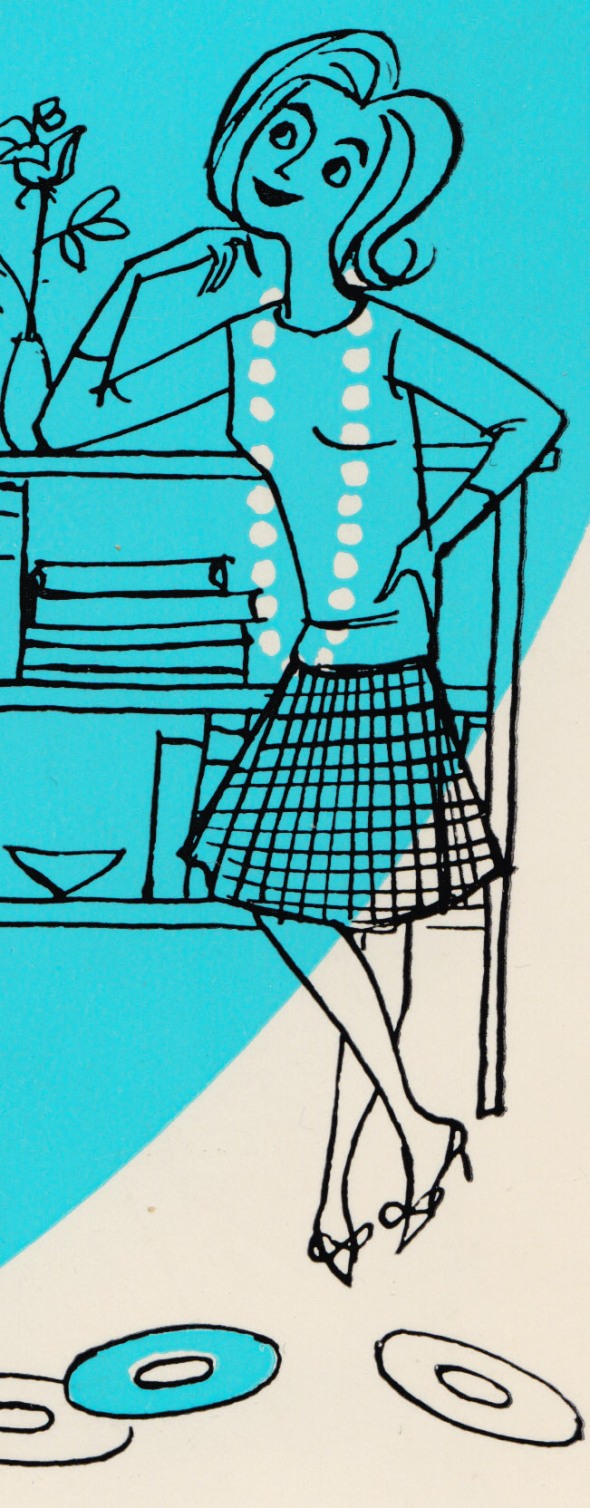



















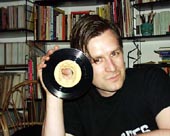 About me:
My name is Andreas Michalke. I´m a cartoonist from Berlin, Germany and I like collecting records. Most of the records I find in thrift stores or at flea markets here in Berlin. I like a lot of music but I thought I`d focus on odd German records. Preferably with cartoon covers.
All my scans are high-resolution. If you double-click on them they will get much bigger.
About me:
My name is Andreas Michalke. I´m a cartoonist from Berlin, Germany and I like collecting records. Most of the records I find in thrift stores or at flea markets here in Berlin. I like a lot of music but I thought I`d focus on odd German records. Preferably with cartoon covers.
All my scans are high-resolution. If you double-click on them they will get much bigger.
Recent Comments